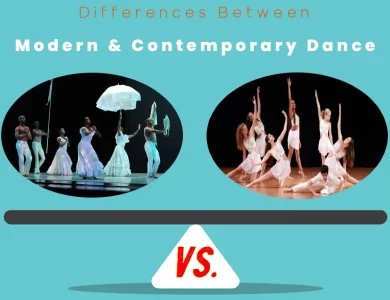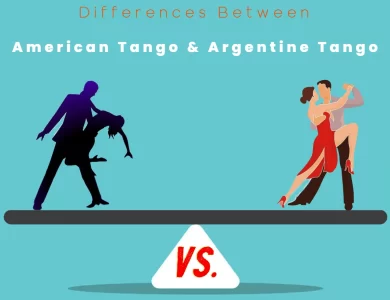Dance
Explore the Vibrant World of Dance: Unraveling the Differences in Terms and Other Items
Welcome to our captivating category page that delves into the enchanting realm of dance! Here, you’ll embark on an enthralling journey where we unravel the nuances of various dance forms, highlighting their unique terminologies and other fascinating aspects. Whether you’re an ardent dance enthusiast or simply curious about the diverse world of movement, this curated collection of content will leave you mesmerized.
-

Kathakali vs Bharatanatyam
Delve into the enchanting world of Indian classical dance as we unravel the captivating differences between Bharatanatyam and Kathakali. These two iconic dance forms, originating from distinct regions of India, showcase diverse styles, themes, and expressions that have enthralled audiences for generations. Bharatanatyam, rooted in the southern Indian state of Tamil Nadu, is a dance form characterized by its precise and graceful movements. It exudes devotion and spirituality, often drawing inspiration from Hindu mythology and religious texts. Dancers convey a wide range of emotions through subtle expressions and hand gestures, creating a spiritual connection with the audience. Bharatanatyam's costumes are elegant and minimalistic, allowing the focus to remain on the dancer's movements and storytelling. Kathakali, on the other hand, hails from the lush landscapes of Kerala in southwestern India. This dance-drama extravaganza is known for its dramatic and exaggerated expressions, elaborate makeup, and vibrant costumes. Kathakali specializes in portraying epic narratives, bringing heroes and villains to life with larger-than-life characters. The training for Kathakali is physically intense, with students immersing themselves in character study and martial art-inspired movements.
-

Contemporary Dance vs Modern
In the captivating realm of dance, two prominent forms stand apart with their unique characteristics and artistic philosophies: Modern and Contemporary Dance. Understanding the distinctions between these dance forms can enrich your appreciation of the art and help you choose the style that resonates most with you. Modern Dance, born out of rebellion against the rigid structures of classical ballet in the late 19th and early 20th centuries, prioritizes natural movements, individuality, and emotional expression. Visionaries like Isadora Duncan and Martha Graham paved the way, emphasizing storytelling through movement and conveying specific themes and emotions. Modern Dance techniques encompass principles such as contract and release, fall and recovery, and breath-initiated movements. Costume choices tend to be simple and functional, allowing the focus to remain on the dance itself. Contemporary Dance, a more recent development in the mid-20th century, is characterized by its fusion of various dance styles, including modern dance, ballet, jazz, and even elements of street dance. This eclectic approach offers greater versatility and experimentation in movement, allowing choreographers and dancers to explore a wide range of styles. Contemporary Dance often embraces floor work, partnering, and improvisation. It thrives on abstract and conceptual choreography, providing artists with the freedom to prioritize movement exploration over linear narratives. Both Modern and Contemporary Dance have left an indelible mark on the world of dance, each offering a unique journey into the realm of human expression through movement. Whether you're drawn to the emotional depth of Modern Dance or the innovative spirit of Contemporary Dance, both forms invite you to explore the rich tapestry of artistic possibilities within the world of dance.
-

Winter Formal vs Winter Ball
As winter casts its enchanting spell, the choice between Winter Ball and Winter Formal beckons. Both events promise memorable evenings, yet they differ in atmosphere and style. Winter Ball emanates elegance, featuring formal attire, classic dances, and opulent decorations that transport you to a bygone era. On the other hand, Winter Formal strikes a balance between formality and relaxation, encouraging diverse dance styles, shorter dresses, and a more laid-back ambiance. Whether you're drawn to the timeless charm of Winter Ball or the inclusive spirit of Winter Formal, each event offers a unique experience that promises laughter, connection, and cherished memories. Discover the nuances and decide which winter celebration resonates with your heart.
-

Argentine Tango vs American Tango
Dive into the captivating realm of dance as we unveil the enchanting differences between American Tango and Argentine Tango. From the origins that shaped their unique styles to the music that guides their movements, these tango variations offer distinct experiences. American Tango, with its precise footwork and formal elegance, contrasts with Argentine Tango's emphasis on emotional connection and improvisation. As you explore their intimate embraces and differing attires, you'll find that each style holds a story of its own. Whether you're drawn to the structured elegance of American Tango or the authentic emotions of Argentine Tango, this exploration will leave you enchanted by the artistry and passion that tango brings to life.
-

Ballet vs Hip hop
Embarking on a dance journey, we delve into the dynamic world of hip hop and the timeless elegance of ballet – two captivating genres that epitomize the diversity of movement and artistic expression. Rooted in urban communities during the 1970s, hip hop is a celebration of freestyle movements and individuality, set to a backdrop of diverse rhythms. On the other hand, ballet traces its heritage to European courts of the 15th century, emphasizing precision, graceful motions, and a strict technical foundation. The contrast continues in the attire each style entails. Hip hop dancers embrace urban chic with loose-fitting clothing and sneakers, reflecting their street culture influence. In contrast, ballet attire exudes timeless elegance, featuring leotards, tights, and ballet slippers that accentuate the body's form and movements.




